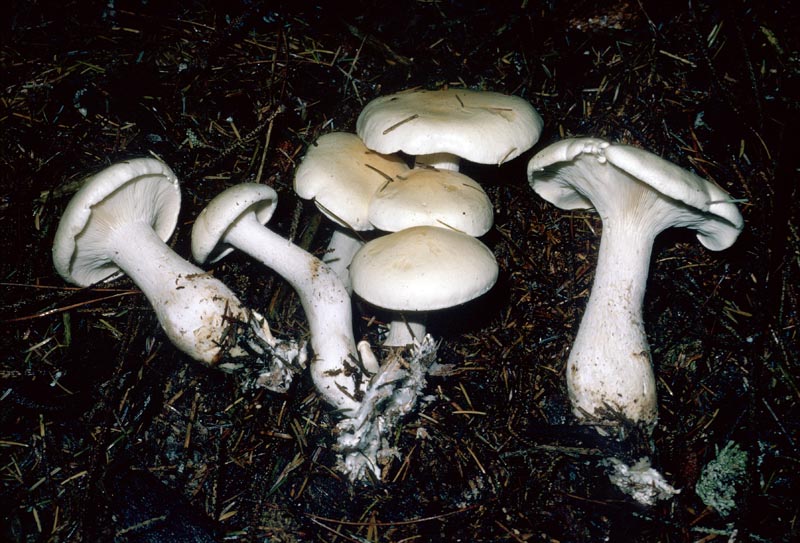
© Steve Trudell
Danny’s DNA Discoveries – Leucopaxillus and Pseudobaeospora of the PNW (Tricholomataceae)
by Danny Miller
|
|
Danny’s DNA Discoveries – Leucopaxillus and Pseudobaeospora of the PNW (Tricholomataceae)
|
|
Introduction
The Tricholomataceae family has traditionally been the largest mushroom family in our area, containing most every gilled mushroom from the Tricholomatineae, Marasmiineae, Hygrophorineae (except for the obviously waxy species) and Pleurotineae sub-orders, as well as others, which now include dozens of families and hundreds if not thousands of mushrooms. Why was it so large? Because if a mushroom had white spores and wasn't distinct like a Russula/Lactarius, waxy cap, Amanita or 'Lepiota', there were not enough discernable differences for anybody to figure out how to separate them any further, so all the rest were lumped in a giant miscellaneous family called "Tricholomataceae" with a note basically saying "TODO: figure this mess out". Thanks to DNA we figured the mess out, but the answer isn't pretty. There are no easily recognizable common characters that humans can see to determine which actual family those mushrooms are in. There's no reason nature had to be kind and make an easy way to tell how they were related to each other. Perhaps we should feel lucky that nature made Russula/Lactarius, Amanita and 'Lepiota' easy to recognize to their families. Leucopaxillus and Pseudobaeospora represent the only genera in the PNW still thought to be closely enough related to Tricholoma to stay in the Tricholomataceae family. 20 years ago if you had to bet which of those hundreds of genera were actually the closest relative of Tricholoma, I bet nobody would have picked these two. Leucopaxillus is mycorrhizal like Tricholoma, so that makes sense, as closely related species often share similar ecologies. However, I hesitate to say that this is the last word and that these genera will stay in the Tricholomataceae after further multi-gene studies are done. But for now, here's where I am presenting them. abundant common uncommon rare - colour codes match my Pictorial Key and are my opinions and probably reflect my bias of living in W WA. Rare species may be locally common in certain places at certain times. |
|
Leucopaxillus
Large, stocky white-spored mushrooms with adnate to decurrent gills that detach easily from the cap flesh, as in Paxillus. Stem base with abundant rhizomorphs. Often bitter. Tough, dense mushrooms, not fragile. Mycorrhizal. Amyloid spores. David Arora once said something like "if you throw a clitocyboid at your friend's forehead and the mushroom breaks, it's a Clitocybe. If it bounces off intact, it's a Leucopaxillus". Aspropaxillus is very large and used to be in Leucopaxillus because of the gills that detach easily and the amyloid spores, but it doesn't have as tough flesh.
Leucopaxillus albissimus group - Completely white with strongly decurrent gills. It remains to be seen how many of these are true genetic species, and how many species are in the PNW. The only 2 local sequences we have match each other, and one was said to resemble var. lentus forma olympianus. We need local collections of all forms and varietals. Leucopaxillus albissimus NY - bitter, pure white and dries white too. Leucopaxillus albissimus var. piceinus IL - bitter, pure white, dries buff to tan in places. Leucopaxillus albissimus var. lentus WA - mild, bald mid-portion of stem, tricholomatoid stature. Leucopaxillus albissimus var. lentus forma olympianus WA - mild, bald mid-portion of stem, clitocyboid stature, few forked gills. Leucopaxillus albissimus var. lentus forma furcatus WA - mild, bald mid-portion of stem, clitocyboid stature, many forked gills. Leucopaxillus albissimus var. paradoxus Caucasus and CA - mild, not bald over mid-portion of stem. Leucopaxillus albissimus var. monticola ID - mild, not bald over mid-portion of stem, abundant cheilocystidia. Leucopaxillus 'albissimus PNW01' - the only species we have local DNA for, it was identified as var. lentus forma olympianus in one slender collection, but is extremely stocky in other. Leucopaxillus 'albissimus PNW01' (as var. lentus f. olympianus) © Jacob Kalichman
Leucopaxillus gentianeus group - brown cap (else white) with adnate gills. Leucopaxillus gentianeus EU ('Leucopaxillus amarus' misapplied name) - with a dark brown cap. The misapplied name 'Leucopaxillus amarus' refers to a Clitocybe so that name should never be used. We have two EU sequences that might be this, and a bunch of local sequences mix in with them. Leucopaxillus 'gentianeus PNW02' - One Idaho sequence from the 40s is 3% different, matching one Victoria, BC and one CA sequence. I don't know if it represents one of the below forms or not. Leucopaxillus gentianeus f. bicolor OR - with an avellaneous cap with a rosy tint. We need collections. Leucopaxillus gentianeus f. roseibrunneus WA - with a dull brown cap. We need collections. unsequenced Leucopaxillus gentianeus group member © Steve Trudell, L. 'gentianeus PNW02' © Dean Lyons (2 images) |
|
Pseudobaeospora
Small (<2.5 cm) silky opaque caps, margin slightly inrolled, thick distant gills, slender but not fragile stems with rhizomorphs at the base, growing on the ground. Saprotrophic. Some are drab but others have beautiful purple tones. They are so obscure that none were known from the west coast until recently when a concerted effort to look for them in California has found more than a dozen species. We have no sequences of any of them from the PNW and most are undescribed, so please collect and save all you find.
Species from CA and elsewhere to be looked for: Pseudobaeospora PNW01 - one collection from WA Pseudobaeospora stevensii CA - one WA collection matches the sequence of 3 CA type area collections. Pseudobaeospora CA02 - one WA collection matches some CA collections. Pseudobaeospora pillodii EU - reported from BC Pseudobaeospora deckeri CA - we have the type sequence Pseudobaeospora aphana CA - one sequence, but not the type A dozen more undescribed CA species probably exist Pseudobaeospora PNW01 © Matthew Koons, P. stevensii © Matthew Koons, P. CA02 © Matthew Koons, unsequenced Pseudobaeospora sp. from WA © Lauren Ré |